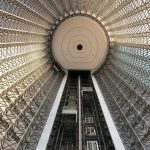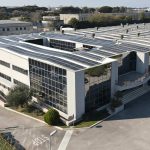Hydraulic lift modernization
Modernization is necessary to bring elevators into compliance with new codes and regulations. The right modernization solution satisfies high performance, reliability, efficiency, superior ride quality and most importantly the ecological expectations. As carbon foot-print of products started being an important product property, ecologic suitability of elevators should be taken as one of the prime driving points in modernizations.Modernization is necessary to bring elevators into compliance with new codes and regulations. The right modernization solution satisfies high performance, reliability, efficiency, superior ride quality and most importantly the ecological expectations. As carbon foot-print of products started being an important product property, ecologic suitability of elevators should be taken as one of the prime driving points in modernizations.Building owners that invest in modernization mainly concern about compliance with new code, ride quality and cost of modernization. This can be done, by partial component changes on existing elevators or completely replacing the existing elevator with a new one. Both approach can successfully bring elevators up-to-date standards and provide smooth ride however, carbon foot-prints of them might become much different.
1. ABOUT MODERNISATION
Elevator companies put forward their own modernization solutions to the market. In fact, all competent elevator companies meet new standard requirements and can provide good ride quality. However, energy consumption and ecological aspects of the solutions could be much different. Nowadays, ecological assessment of elevator modernization is wrongly degraded to energy consumption only, omitting the fact that material and maintenance are two other major factors to be considered together with the energy consumption for a true evaluation.Modernization of hydraulic elevators should be evaluated much differently than traction elevators. This is because hydraulic elevators are used up to 5 to 6 floors and over 70% of which are low-usage. A low-usage elevator can be suitably modernized by using a conventional hydraulic elevator easily. Though its energy consumption during operation is higher than an advance technology hydraulic or traction elevator, the initial investment, running costs and in most cases the total carbon-foot print of the conventional hydraulic elevator are much lower.In modernizations one of the most important components is the elevator controller. While with new generation elevator controllers energy consumption at stand-by can be reduced to the minimum. For a hydraulic elevator system, apart from the drive unit and safety systems the rest of the elevator systems are the same as for the traction elevators. The elevator controller only differentiates with the way it interfaces to the control and safety valves. Therefore we will herein mainly consider modernization of power unit, control valves and try to correct the most common mistakes made on modernization of hydraulic elevators.
2. WHAT TO MODERNIZE
An important step before going for a modernization is to check the elevator technical data and conditions of working environment in order to determine if the power unit, control valve group and cylinder(s) are really suitable for the elevator. In this way previously made design mistakes can be find out and corrected. Change of usage of the elevator throughout years, application of new codes and regulations may require modifications in elevator speed or/and capacity which might require new components to be used. That is, an intensive study of the existing system is needed to determine what to renew and what to reuse. Replacing an existing elevator with completely a new one should be the last option while this is the most expensive and environmentally worse choice.
2.1 Modernization of power units
Power unit produces flow and determines the maximum speed of the ram. Empty cabin weight on the ram and pay-load of the elevator give the working pressure range. When power unit is out of date or/and speed of the elevator or lifting capacity is modified, the power unit may be renovated. Depending on the hydraulic drive technology used, internal design, control valve, connections and size of the power unit might be re-designed.
2.2 Modernization of the cylinder
Unless it is a must never change the hydraulic cylinder. It may increase the modernization cost considerably. Replacement of seals, drain pipes, checking the suspension system and protecting against corrosion are mostly good enough during modernization.However, damaged or bended rams, heavily corroded cylinders, telescopic cylinders with synchronization problem should be renovated or replaced. Another reason for cylinder replacement is the change of lifting capacity. To satisfy buckling strength or allowable working pressure range cylinder could be changed. As a rule of thumb, when elevator traffic analysis allows decreasing lifting capacity of the elevator is more practical instead of renewing the cylinder.
2.3 Using “Advance technology”
Use of inverters in hydraulic elevators has decreased energy consumption, allowed smaller motor power, eliminated high surge currents, auditable noise, oil heating and provided good ride performance. This is in general called as “Advance technology”. Advance elevator technology has been incorrectly reflected like; it provides always the most energy efficient solution, perfectly suits every installation and can regenerate energy at every condition. Firstly, the level of advanced technology used in modernizations depends on the usage of the elevator. Secondly, correct selection of the advance technology is vital to obtain the aforementioned benefits (There are many advance hydraulic elevators solutions in the market from the most innovative to a very primitive one).Investing the most advanced vertical transportation technology on a low-usage elevator is normally not feasible, while the investment in such a case, might pay itself back above 100 years.This is because of the fact that the inverter and its peripheral devices are costly and require energy to be active even when the elevator is at stand-by. In fact, no solution is attractive and even ecological if it is not cost-effective. Keeping this in mind, for example, a low-usage elevator in a two-three floor house with less than 20 cycles per day normally requires up-date of some essential components in order to comply with the new codes. If necessary, elevator controller can be modified or replaced to minimize stand-by energy consumption and surge current. A good quality mechanical valve would be sufficient for such elevators (while the fluid temperature keeps nearly constant).On the other hand, for high usage elevators using advance technologies like vvvf-driven control valves, introduces high level of energy savings, better ride quality and shorter pay-back period of the investment.That is, highly advance technology solutions are mostly suitable for high-usage elevators.Regenerative drives that generate energy during down travel are much more costly and therefore can be only feasible to be used for heavily used elevators. On low-usage elevators, the investment on a regenerative inverter will never pay itself off during a human lifetime.
3. ELEVATOR MARKETNEEDS FOR MODERNIZATION
Though the general trend in the elevator industry is towards lifts with lower energy requirement, use of hydraulic elevators with inverter (vvvf-driven control valves) has not found enough appeal yet. This is because of the fact that existing solutions are generally more demanding, rather costly and maintenance requires high level of expertise. Therefore, a transition solution with electronic control valves is used mostly for modernizations. Electronic valves provide in general 12 % to 14% energy savings (if it has an energy saving mode this might become about 28%) compared 40% to 65% with vvvf-driven valves. On the other hand, high starting current, auditable noise level and oil heating characteristics will be similar than the mechanical valves.There are close correlations amongst energy savings, pay-off duration of the investment and usage of the elevator. This is shown in Figure 2.With increasing elevator usage pay-off duration of the investment decreases and energy saving increase. In order to establish an acceptable solution for the market; compact, simple to implement and inexpensive VVVF-driven advance solutions are needed. Since most of the hydraulic elevators are low-usage, it is necessary that the solution is practical and require low amount of investment to be applicable for low-usage elevators. In order to offer a cost effective solution, installation and maintenance properties are of prime importance. Therefore having a complex solution with many closed loop systems nested into each other, using motor encoder and special control board would require expert technicians to install and maintain the system. As a result the system cost will increase and pay-off duration will become much longer.Solutions like EV4-VVVF by Blain Hydraulics introduced to the market a compact, simple and inexpensive that can be applied also low usage elevators with short pay off durations. EV4-vvvf is also a perfect control valve for modernizations. This is because it allows the existing power units and elevator controllers to be re-used by replacing the control valve with the EV4-vvvf valve and placing the inverter next to the elevator controller. If the existing power unit has a Blain EV100 or SEV valves, these can be converted easily into EV4-vvvf valve by using a renovation kit only. This helps modernizations to be done quickly and shortens the pay-off duration.
3.1 Circular economy, environmentalimpact and elevator modernization
The circular economy aims to rely on renewable energy, minimizes tracks and eliminates the use of toxic chemicals and gets rid of waste through careful design. In this economic model, materials and components of a product are designed for re-using without giving out waste. On the other side, global warming and environmental pollution concerns are the driving forces that persuade manufacturers to produce energy efficient products. As a result of the inclination towards optimum utilization of world resources, environmental impact of elevator systems has also become one of the main issues in the elevator sector. Life Cycle Assessment (LCA) is the method to determine the environmental impact of products, which is also applicable to evaluate environmental performance of elevators.When it comes to modernization re-use of the most existing hydraulic components becomes prime importance for the user and for the environment. Many parts in a used elevator are not worn out and can be kept for many decades. Considering the fact that more than 3.5 million hydraulic elevators running worldwide, replacing only the necessary ones and reuse of other existing components, instead of replacing all of them, reduces the environmental impact and saves money.
3.2 A recent study
A recent study by Hydroware Elevation Technology Ab of Sweden (www.hydroware.de/lib/get/file.php?id=155f9221554af7) on new elevator installations and modernizations for low-usage lifts (average 50 trips/day) clearly showed that hydraulic elevators are much more environmentally friendly than traction ones. Figure 3 shows comparisons of environmental impacts for new installations (hydraulic and traction). The total environmental impact for hydraulic elevator is 7% less than the traction.In Figure 4, environmental impacts are compared between hydraulic elevator modernization (usage category 1) and full replacement of a hydraulic elevator with a traction one.Therein, the environmental impact with the traction elevator is 43% higher.That is, modernizing a low-usage hydraulic elevator with a traction one is rather unfavourable for the environment. The impact of maintenance given in Figure 3 and Figure 4 only considered the regular service visits since there were no records of failure rates.Adding break-downs and repairs would probably increase traction elevator impact even more.In general, hydraulic elevators are much more reliable than traction elevators therefore, their maintenance generates much less impact. Hydraulic elevator, possessing simple construction, having less number of components and working all in lubricated environment, extends the lifecycle and allows less system down time resulting in significant cost savings.It should be remembered that maintenance of elevators 2 to 10 times higher than the yearly energy consumption.In addition, the most expensive spare part of a traction MRL (Machine Roomless) is over 30% of the total elevator cost while it is about 4% to 6% for hydraulic elevator.In the light of above results and evaluations, when modernization is in question, full replacement of hydraulic elevators with traction one would be disastrous for the environment, hydraulic elevators allow many components to be re-used because of their structure and provide better modernization solutions for the environment.
4. Biographical details
Dr. Ferhat Celik graduated as Mechanical Engineer from Istanbul Technical University (Turkey) and later obtained his MSc and PhD degrees from University of Manchester, UMIST (UK). He worked for Istanbul University as Assistant Professor for seven years before joining Blain Hydraulics (Germany), manufacturer of hydraulic elevator valves where, he operates as Engineering-Marketing Manager and as International Coordinator.
K. Ferhat Celik
Blain Hydraulics
Heilbronn, Germany









